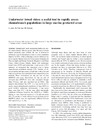Identificador persistente para citar o vincular este elemento:
https://accedacris.ulpgc.es/jspui/handle/10553/3155
| Campo DC | Valor | idioma |
|---|---|---|
| dc.contributor.author | Assis, Jorge | en_US |
| dc.contributor.author | Narvaez, Krupskaya | en_US |
| dc.contributor.author | Haroun, Ricardo | en_US |
| dc.date.accessioned | 2010-03-12T02:31:00Z | - |
| dc.date.accessioned | 2018-03-07T09:05:44Z | - |
| dc.date.available | 2018-03-07T09:05:44Z | - |
| dc.date.issued | 2007 | en_US |
| dc.identifier.issn | 1400-0350 | en_US |
| dc.identifier.other | Scopus | - |
| dc.identifier.uri | https://accedacris.ulpgc.es/handle/10553/3155 | - |
| dc.description.abstract | Elasmobranch stock assessment studies are usually\nmade through fisheries surveys data. However, in large\nmarine protected areas (MPAs) the use of destructive\ntechniques must be dismissed in order to avoid population\nimpacts. In 2005, while conducting a marine habitat survey\nin two marine Special Areas of Conservation (Sebadales de\nPlaya de Inglés and Franja Marina de Mogán) in south Gran\nCanary Island (Canary Islands, Spain) with underwater\ntowed video (UTV) and underwater visual census (UVC)\ntransects, we recognized the opportunity rose to assess\nelasmobranch populations through UTV. Number of observed\nspecies and specimens, overall field work effort and\ntotal surveyed area were determined and compared between\nmethods. Mean observations per day per unit of time\n(MOPUT) and mean observations per day per unit of\nsurveyed area (MOPUA) were also compared through\nMann–Whitney rank sum statistical test (α=0.05). Data\nanalysis demonstrated that UTV is a very useful tool to\nrapidly assess elasmobranch populations in large MPAs in\ngood visibility underwater environments. It can assess\nlarger areas than UVC with the same effort (statistically\nsignificant difference found for the MOPUT; p=<0.001),\nleading to more observed species (5 vs 2) and specimens\n(46 vs 3) per day of work, with no loss in resolution power\n(MOPUA values were not significantly different between\nUTV and UVC; p=0.104). | en_US |
| dc.language | eng | en_US |
| dc.relation.ispartof | Journal of Coastal Conservation | en_US |
| dc.source | Journal of Coastal Conservation [ISSN 1400-0350], v. 11 (3), p. 153-157, (Diciembre 2007) | en_US |
| dc.subject | 240106 Ecología animal | en_US |
| dc.subject | 240114 Taxonomía animal | en_US |
| dc.subject.other | Elasmobranch | en_US |
| dc.subject.other | Abundance estimation | en_US |
| dc.subject.other | Underwater video | en_US |
| dc.subject.other | Monitoring methods | en_US |
| dc.title | Underwater towed video: a useful tool to rapidly assess elasmobranch populations in large marine protected areas | en_US |
| dc.type | info:eu-repo/semantics/article | en_US |
| dc.type | info:eu-repo/semantics/article | en_US |
| dc.type | Article | en_US |
| dc.identifier.doi | 10.1007/s11852-008-0015-x | en_US |
| dc.identifier.scopus | 78651310185 | - |
| dc.contributor.authorscopusid | 53463298700 | - |
| dc.contributor.authorscopusid | 57200158998 | - |
| dc.contributor.authorscopusid | 6603827643 | - |
| dc.identifier.absysnet | 583527 | - |
| dc.identifier.crisid | -;-;1266 | - |
| dc.description.lastpage | 157 | en_US |
| dc.identifier.issue | 3 | - |
| dc.description.firstpage | 153 | en_US |
| dc.relation.volume | 11 | en_US |
| dc.investigacion | Ciencias | en_US |
| dc.type2 | Artículo | en_US |
| dc.utils.revision | Sí | en_US |
| dc.date.coverdate | Diciembre 2007 | en_US |
| dc.identifier.supplement | -;-;1266 | - |
| dc.identifier.ulpgc | Sí | es |
| dc.description.scie | SCIE | |
| item.grantfulltext | open | - |
| item.fulltext | Con texto completo | - |
| crisitem.author.dept | GIR ECOAQUA: Biodiversidad y Conservación | - |
| crisitem.author.dept | IU de Investigación en Acuicultura Sostenible y Ec | - |
| crisitem.author.dept | Departamento de Biología | - |
| crisitem.author.orcid | 0000-0003-1348-692X | - |
| crisitem.author.parentorg | IU de Investigación en Acuicultura Sostenible y Ec | - |
| crisitem.author.fullName | Haroun Tabraue, Ricardo Jesús | - |
| Colección: | Artículos | |
Este elemento está sujeto a una licencia Licencia Creative Commons

